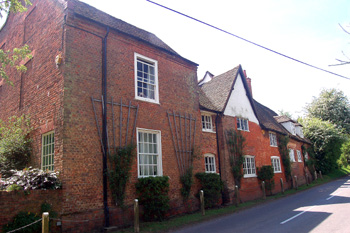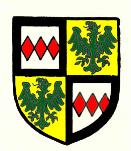Swineshead Manors

Manor Farmhouse May 2008
Domesday Book of 1086
In the Domesday Book of 1086, when Swineshead was in Huntingdonshire, it was declared by "sworn men" that King Edward the Confessor gave Swineshead to Earl Siward of Northumbria "and so Earl Harold had it [rather than Siward's son Waltheof]; moreover that (its men) paid tax in the Hundred [of Kimbolton] and went with them against the enemy". In 1086 there were two manors in Swineshead. The smaller, just half a hide and one villager, belonged to Eustace the Sheriff, whose tenant was called Ralph, the previous tenant having been someone called Fursa. The value before 1066 had been fifteen shillings and in 1086 was just six.
The larger manor belonged to William de Warenne, whose tenant was one Eustace, perhaps Eustace the Sheriff though this is not explicitly stated. The manor comprised three and a half hides and had one freeman, seven villagers and five smallholders. The value was forty shillings.

Montagu coat of arms
Manors
It seems likely that the smaller of the two Domesday manors merged at some point with William de Warenne's much larger manor. De Warenne was a longstanding ally of William the Conqueror's in Normandy. He fought against Hereward the Wake's rebels in the fens around Ely in 1071 and died of wounds during the rebellion by Robert Curthose, the Conqueror's eldest son, against his brother William II Rufus. At some point, perhaps just before his death, he had been created Earl of Surrey.
The first known tenant of the manor after Eustace was Walter de Swineshead who, in 1163, was recorded as owing two marks (£1/6/8) for trespassing in the King's forests. Another Walter was tenant in 1244, holding the manor from the Bohun family, Earls of Hereford and Essex (who became overlords about 1293, holding the manor directly from the King). After Walter Earl Humphrey de Bohun granted the tenancy to Geoffrey de Skeffington, from whom it passed to Isabel de Erchtdehene, who sublet it to William de Castre for four years from 1276, as guardian for Walter, son of Ralf de Swineshead, who was a minor. Walter may have died young as in 1290 his mother Isabella was tenant. A Robert de Swineshead, possibly a brother of Walter, was outlawed for a felony in 1293 and the manor passed to the King for a year, reverting to Humphrey de Bohun in 1294. He granted it for life to Bartholomew de Enfield and he later granted the reversion to his son William de Bohun, who became Earl of Northampton in 1337.
The manor remained in the possession of the Bohun family until Eleanor Bohun married Thomas Plantagenet, Earl of Gloucester. Her daughter married Edmund de Stafford, Earl of Stafford and at her death her son Humphrey Stafford, earl (later Duke) of Buckingham succeeded to the manor. Buckingham was a Lancastrian during the Wars of the Roses and was killed at the Battle of Northampton in 1460. He had a son, Henry, but his property remained in the hands of the Crown. Richard III granted the manor to Thomas, Lord Stanley in 1484 but on his accession, the next year, Henry VII restored it to Edward, Duke of Buckingham. This 3rd Duke of Buckingham was executed for treason in 1521 and his lands were forfeited.
In 1523 Henry VIII granted the manor to Sir Richard Wingfield and it remained in that family's hands until 1615 when reversion of the manor was granted to Sir Henry Montagu, who was created Earl of Manchester in 1623. His grandson, the third Earl became the first Duke of Manchester and the manor remained in the family into the 20th century.